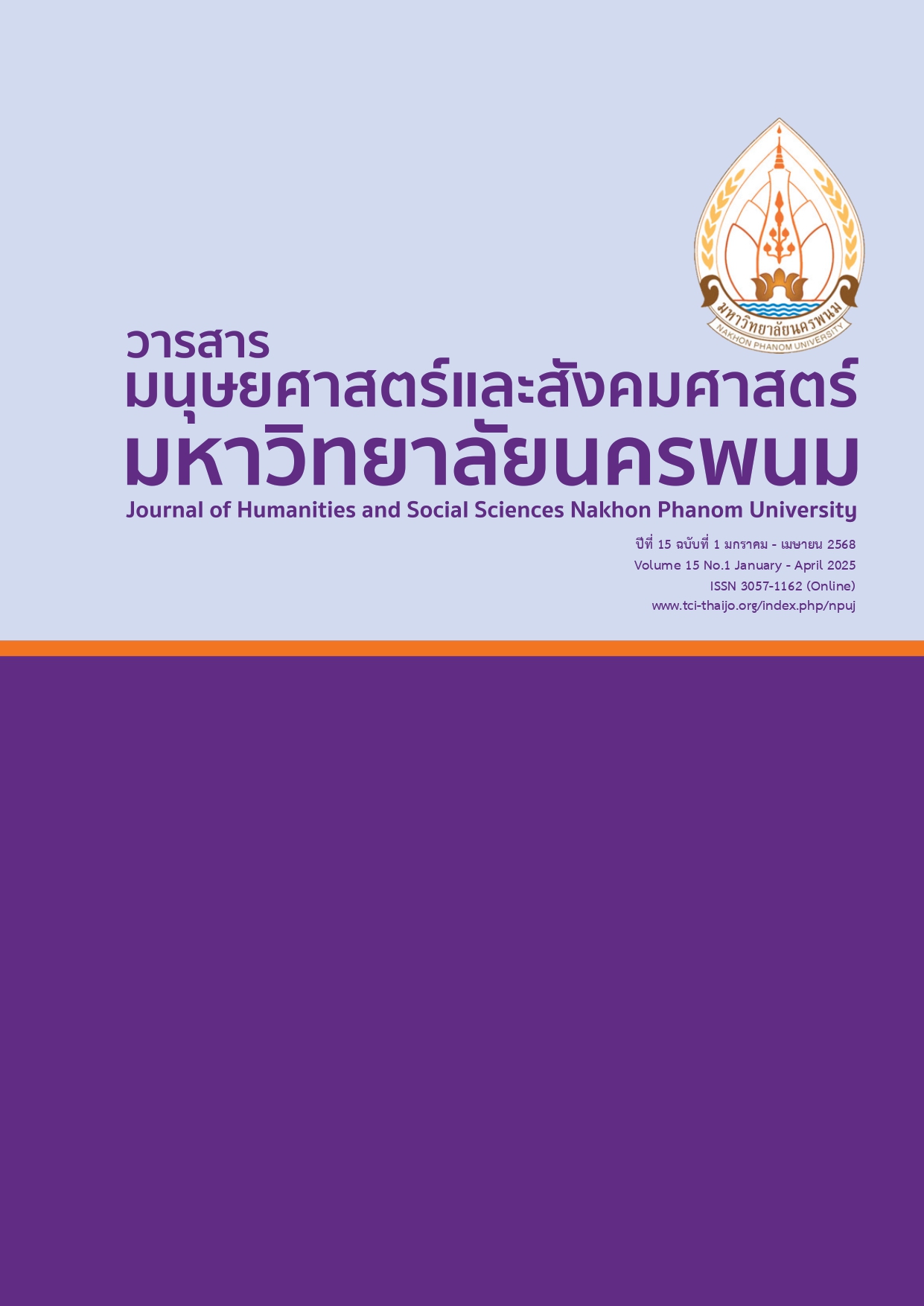Awareness and Acceptance of Risk Factors Influencing the Digital Currency Usage Intention in Thailand
Main Article Content
Abstract
This study aims to study the levels of risk awareness, technology acceptance, and intention to use digital currencies in Thailand and study risk awareness and technology acceptance factors affecting the intention to use digital currencies in the country. The sample of this quantitative research consisted of 400 Thai nationals who have never used but are considering using digital currencies for investment purposes. The data was collected through an online questionnaire via Facebook, utilizing non-probability convenience sampling. The data analysis used means, standard deviations, and multiple regression analysis. The findings revealed that 1) the overall level of risk awareness was high, 2) the overall level of technology acceptance was at the highest level, 3) the overall level of intention to use digital currencies in Thailand was at the highest level, and 4) financial and time-related risk factors significantly influence the intention to use digital currencies. From the hypothesis testing, it was found that transaction fees, the duration of time required to learn how to use digital currencies, and the duration of time spent on the registration process negatively affected the intention to use digital currencies in Thailand, and the worthiness of time invested positively influenced the intention to use digital currencies in Thailand, significantly at the 0.05 level.
Article Details

This work is licensed under a Creative Commons Attribution-NonCommercial-NoDerivatives 4.0 International License.
References
Chaonchom, O., Jairak, K. & Chai-amonphaisal, K. (2024). Effect of Technology Acceptance User Trust and Perceived Risk Toward Consumer Cryptocurrency Investment Decision in Mueang Chiang Mai District Chiang Mai Province. Payap University Journal, 34(1), 17-33. https://doi.org/10.14456/pyuj.2024.2
Cohen, J. (1988). Statistical Power Analysis for the Behavioral Sciences (2nd ed.). Lawrence Erlbaum Associates.
Davis, F. D. (1989). Perceived Usefulness, Perceived Ease of Use, and User Acceptance of Information Technology. MIS Quarterly, 13(3), 319-340. https://doi.org/10.2307/249008
DataReport. (2022). Digital 2022: Big Rise in Cryptocurrency Ownership. Retrieved December 2023, from
https://datareportal.com/reports/digital-2022-big-rise-in-cryptocurrency-ownership
Demirdogen, O., Yaprakli, S., Yilmaz, M. K. & Husain, J. (2010). Customer Risk Percept? ons Of Internet Banking–A Study In Turkey. Journal of Applied Business Research. (JABR), 26(6), 57-65. https://doi.org/ 10.19030/jabr.v26i6.329
Digital Economy Compass. (2022). The Ascent of The Crypto Economy. Retrieved December 2023, from https://www.statista.com/study/112911/digital-economy-compass-2022-chapter-1/
Dowsiriroj, P. (2022). A Study of Adoption of technology Affecting Gamfi Investment Decisions of Social Media Consumers in Thailand (Unpublished master’s thesis). Mahidol University, Nakhon Phatom, Thailand.
Gujarati, D. N. & Porter, D. C. (2009). Basic Econometrics (5th ed.). McGraw-Hill Education.
Huang, C. K., Lee, N. C. A. & Chen, W. C. (2023). Dilemmatic Dual-Factor Determinants of Discontinuous Intention in Cryptocurrency Usage. Information Technology & People, 36(2), 564-594. https://doi. org/10.1108/ITP-11-2020-0778
Kanoklertwonges, P. (2021). Digital Money and Financial Freedom to the Thai Economy. Humanities and Social Science Research Promotion Network Journal, 4(3), 79-91. https://so06.tci-thaijo.org/index. php/hsrnj/article/download/253668/171597/917564
Lerdloompheephan, P. (2024). The Digital Transaction (Security Computer Crimes and Risk) Integration Model in The Context of Digital Technology Adoption. Panyapiwat Journal, 16(2), 1-15 https://so05.tci-thaijo.org/index.php /pimjournal /article/view/268773
Likert, R. (1967). The Method of Constructing and Attitude Scale in Attitude Theory and Measurement. Wiley and Son.
Mohammad Al-Quraish, P. (2020). Technology Acceptance, Online Consumer Behavior and Risk Perception Related to Decision-Making on Using Cryptocurrency Among Consumers in the Bangkok Metropolitan Area (Unpublished master’s thesis). Srinakharinwirot University, Bangkok, Thailand.
Namahoot, K. S. & Rattanawiboonsom, V. (2022). Integration of TAM Model of Consumers’ Intention to Adopt Cryptocurrency Platform in Thailand: the Mediating Role of Attitude and Perceived Risk. Human Behavior and Emerging Technologies, 4(1), 1-12. https://doi.org/10.1155/2022/9642998
Parnami, P. & Mathur, S. (2022). Awareness and adoption of cryptocurrency among entrepreneurs of Jaipur city. Inspira J Mod Manag Entrepreneurship JMME, 12(03), 07-12. https://www.researchgate.net/ publication/ 363151262_ AWARENESS_AND _ADOPTION_OF_CRYPTOCURRENCY_AMONG_ENTREPRENEURS_OF_JAIPUR_CITY
Planet46. (2023). What is a Cryptocurrency Bring Beginners to Understand Everything in One Place. Retrieved December 2023, from https://www.finnomena.com/planet46/what-is-cryptocurrency/
Plisio. (2023). Global Cryptocurrency Adoption Statistics in 2023. Retrieved December 2023, from https:// plisio.net/th/blog/cryptocurrency-adoption-statistics-worldwide-in-2023.
Poomkalorn, S. (2020). A Study of the Risk of Promtpay System Usage (Unpublished master’s thesis). Rangsit University, Pathum Thani, Thailand.
Ritthichai, P. (2020). The Relationship Between The Customers’ Perceptions of Risk and Adoption of Technology and Their Electronic Transaction Service Usage Behaviors of Kasikorn Bank in Ssraburi Province (Unpublished master’s thesis). Rajamangala University of Technology Thanyaburi. Pathum Thani, Thailand.
Robkob, A. & Muenthaisong, K. (2023). Investment Attitude in Digital Assets of The Y Generation Investors in Thailand. Jounal of Business Administration Maejo University, 5(1), 70-91. https://doi.org/10.14456/ mjba.2023.4
Saithong, O., Patmanee, P., Chivasopit, V. & Srianurakwong, S. (2022). Attitudes Affecting the Intention to Use Digital Currency (Bitcoin) of Female Consumers in Phuket Province. Journal of Business Administration and Social Sciences Ramkhamhaeng University, 5(3), 131-144. https://so02.tci-thaijo.org/index.php/ibas /article/view/257910/174785
Sujoko, D. A., Fahreza, M. F. & Atmojo, R. N. P. (2023). Intention to Use Cryptocurrency Exchanges: Assessing Cryptocurrency Exchange Features. In 2023 10th International Conference on ICT for Smart Society (ICISS) (pp. 1-9). IEEE. https://doi.org/10.1109/ICISS59129.2023.10291995
Suriyan, K., Taweeruksakul, R., Promyat, P. & Hoyyeepoo, C. (2023). Adoption and Use of Technology Affecting Intention to Use Digital Currency in Thailand. Journal of Roi Kaensarn Academi, 8(6), 1-20. https://so02.tci-thaijo.org/index.php/ JRKSA/article /view/261957/176495
Teerawongsathorn, C. (2022). A Study of Technology Acceptance Impacting Intention to Use Buy Now Later (Spaylater) Among Generation Z in Thailand (Unpublished master’s thesis). Thammasat University, Bangkok, Thailand.
Tosborvorn, T. (2022). Do Thai People Hold the Most Crypto in the World. Retrieved December 2023, from https://www.pier.or.th/blog/2022/0601/
Vanichbuncha, K. (2018). Using SPSS for Windows for data analysis. Chula Book.


